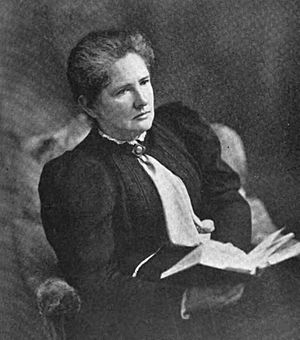Laura E. Richards facts for kids
Quick facts for kids
Laura Elizabeth Howe Richards
|
|
|---|---|
 |
|
| Born | February 27, 1850 74 Mount Vernon Street Boston, Massachusetts |
| Died | January 14, 1943 (aged 92) Gardiner, Maine |
| Notable awards | 1917 Pulitzer Prize |
| Spouse | Henry Richards |
| Children | 7 (Alice Maud, Rosalind, Henry Howe, Maud, John, Laura Elizabeth) |
| Relatives |
|
Laura Elizabeth Howe Richards (born February 27, 1850 – died January 14, 1943) was an American writer. She wrote over 90 books! These included stories about people's lives, poetry, and many books especially for children. One of her most famous children's poems is the funny, silly verse called "Eletelephony".
Contents
Who Was Laura Elizabeth Howe Richards?
Laura Elizabeth Howe was born in Boston, Massachusetts, on February 27, 1850. Her father was Dr. Samuel Gridley Howe. He was an abolitionist, which means he worked to end slavery. He also started the Perkins Institution and Massachusetts School for the Blind, a famous school for blind people. Laura was even named after his well-known deaf-blind student, Laura Bridgman. Her mother, Julia Ward Howe, wrote the words to the famous song "The Battle Hymn of the Republic".
In 1871, Laura married Henry Richards. In 1876, they moved to Gardiner, Maine, with their three children. Henry worked at his family's paper mill there.
In 1917, Laura won a special award called the Pulitzer Prize. She won it for a biography (a book about someone's life) called Julia Ward Howe, 1819-1910. She wrote this book about her mother along with her sisters, Maud Howe Elliott and Florence Hall.
Laura Elizabeth Howe Richards passed away on January 14, 1943, in Gardiner, Maine. She was almost 93 years old.
Laura Richards' Lasting Impact
Laura Richards left behind an important legacy. A school for young children in Gardiner, Maine, is named after her. It's called the Laura E. Richards School.
Her children's book Tirra Lirra won the Lewis Carroll Shelf Award in 1959. This award celebrates books that are like Alice in Wonderland. Her home in Gardiner, the Laura Richards House, is also a special place. It's listed on the National Register of Historic Places, meaning it's an important historical building.
Laura Richards' Books
Laura Richards wrote many different kinds of books. She often wrote poems for St. Nicholas Magazine, a popular children's magazine.
Biographies (Stories About Real People)
Laura wrote books about the lives of many important people. These included:
- Florence Nightingale: Angel of the Crimea (1909) - About the famous nurse.
- Two Noble Lives: Samuel Gridley Howe and Julia Ward Howe (1911) - About her parents.
- Julia Ward Howe, 1819-1910 (1915) - The book that won her a Pulitzer Prize.
- Laura Bridgman: The Story of an Opened Door (1928) - About the deaf-blind student she was named after.
Other Books (Including Children's Stories)
Laura Richards also wrote many stories and poems for children. Some of her well-known books include:
- The Joyous Story of Toto (1885)
- Beauty and the Beast (retelling, 1886)
- Hop o' My Thumb (retelling, 1886)
- Captain January (1891) - This book was even made into a movie in 1936 starring Shirley Temple!
- Five Minute Stories (1895)
- Tirra Lirra: Rhymes Old and New (1932) - This book won an award.
- Merry-Go-Round: New Rhymes and Old (1935)
She also wrote several popular series for young readers:
- The Hildegarde Series (5 books, starting with Queen Hildegarde in 1889)
- The Melody Series (4 books, starting with Melody in 1893)
- The Margaret Series (6 books, starting with Three Margarets in 1897)

